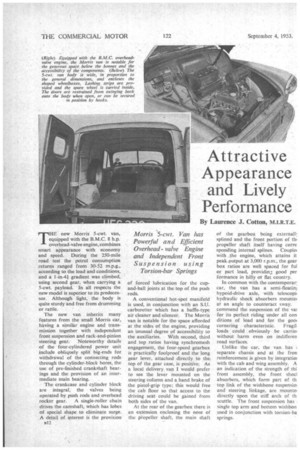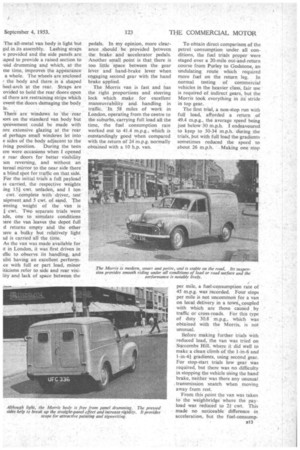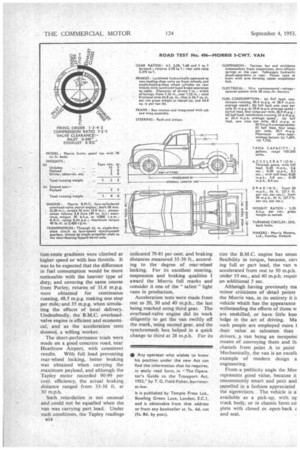Attractive Appearance and Lively Performance
Page 46

Page 47

Page 48

If you've noticed an error in this article please click here to report it so we can fix it.
By Laurence J. Cotton, M.I.R.T.E.
Morris 5-cwt. Van has Powerful and Efficient Overheadvalve Engine and Independent Front Suspension using Torsion-bar Springs
T. new Morris 5-cwt. van, equipped with the B.M.C. 8 h.p. overhead-valve engine, combines smart appearance with economy and speed. During the 250-mile road test the petrol consumption returns ranged from 30-52 m.p.g., according to the load and conditions, and a 1-in-41 gradient was climbed, using second gear, when carrying a 5-cwt. payload. In all respects the new model is superior to its predecessor. Although light, the body is quite sturdy and free from drumming or rattle.
The new van inherits many features from the small Morris car, having a similar engine and transmission together with independent front suspension and rack-and-pinion
steering gear. Noteworthy details of the four-cylindered power unit include obliquely split big-ends for withdrawal of the connecting rods through the cylinder-block bores, the use of pre-finished crankshaft bearings and the provision of an inter mediate main bearing. .
The crankcase and cylinder block are integral, the valves being operated by push rods and overhead rocker gear. A single-roller chain drives the camshaft, which has lobes of special shape to eliminate surge. A detail of interest is the provision i312 of forced lubrication for the cupand-ball joints at the top of the push rods.
A conventional hot-spot manifold is used, in conjunction with an S.U. carburetter which has a baffle-type air cleaner and silencer. The Morris van is notable for the space afforded at the sides of the engine, providing an -Unusual degree of accessibility to
the auxiliaries. With second, third and top ratios having synchromesh engagement, the four-speed gearbox is practically foolproof and the long gear lever, attached directly to the top of the gear case, is positive. As a local delivery van I wotfid prefer to see the lever mounted on the steering column and a hand brake of the pistol-grip type; this would free the cab floor so that access to the driving seat could be gained from both sides of the van. of the gearbox being externall] splined and the front portion of thi propeller shaft itself having corm sponding internal splines. Couple4 with She engine, which attains it peak output at 3,000 the gear box ratios are well spaced for ful or part load, providin3 good per formance in hilly Or flat country.
In common with the contemporar ear, the van has a semi-float in hypoid-drive axle, with telescopil hydraulic shock absorbers mountei at an angle to counteract sway. commend the suspension of the val for its perfect riding under all con ditions of load and for the goal cornering characteristic. Fragil. loads could obviously be carriei without harm even On indifferen road surfaces.
Unlike the car, the van has separate chassis and at the fron reinforcement is given by integratioi with the cab and wing assembly. A an indication of the strength of thi front assembly, the front shod absorbers, which form part of th top link of the wishbone suspensiol and steering linkage, are mountei directly upon the stiff arch of th scuttle. The front suspension has single top arm and bottom wishbon used in conjunction with torsion-ba springs. The all-metal van body is light but lid in its assembly. Lashing straps e provided and the side panels are aped to provide a raised section to 'aid drumming and which, at the me time, improves the appearance a whole. The wheels are enclosed the body and there is a shaped heel-arch at the rear. Straps are ovided to hold the rear doors open td there are restraining strips which event the doors damaging the body Ie.
There are windows to the rear Hark on the standard van body but iprovement could be made with ore extensive glazing at the rear Id perhaps small windows let into e sides of the body adjacent to the iving position. During the tests ere were occasions when I opened e rear doors for better visibility len reversing, and without an ternal mirror to the near side there a blind spot for traffic on that side. For the initial trials a full payload ts carried, the respective weights ing 15i cwt. unladen, and 1 ton cwt. complete with driver, test uipment and 5 cwt. of sand. The ensing weight of the van is f cwt. Two separate trials were ide, one to simulate conditions iere the van leaves the depot full d returns empty and the other lere a bulky but • relatively light Id is carried all the time.
As the van was made available for ;t in London, it was first driven in tffic to observe its handling, and last having an excellent performce with full or part load, minor iticisms refer to side and rear visility and lack of space between the pedals. In my opinion, more clearance .should be provided between the brake and accelerator pedals. Another small point is that there is too little space between the gear lever and hand-brake lever when engaging second gear with the hand brake applied.
The Morris van is fast and has the right proportions and steering lock which make for excellent manoeuvrability and handling in traffic. In 58 miles of work in London, operating from the centre to the suburbs, carrying full load all the time, the fuel consumption rate worked out to 41.4 m.p.g., which is outstandingly good when compared with the return of 24 m.p.g. normally obtained with a 10 h.p. van. To obtain direct comparison of the petrol consumption under all conditions, the fuel trials proper were staged over a 20-mile out-and-return course from Purley to Godstone, an undulating route which required more fuel on the return leg. In normal testing of commercial vehicles in the heavier class, fair use is required of indirect gears, but the Morris took everything in stride in top gear.
The first trial, a non-stop run with full load, afforded a return of 49.4 m.p.g., the average speed being just below 30 m.p.h. I endeavoured to keep to 30-34 m.p.h. during the trials, but with full load the gradients sometimes reduced the speed to about 26 m.p.h. Making one stop per mile, a fuel-consumption rate of 45 m.p.g. was recorded. Four stops per mile is not uncommon for a van on local delivery in a town,, coupled with which are those caused , by traffic or cross-roads. For this type of duty 30,8 m.p.g., which was obtained with the Morris, is not unusual.
Before making further trials with reduced load, the van was tried on Succombs Hill, where it did well to make a clean climb of the 1-in-6 and 1-in-41 gradients, using second gear. For stop-start trials low gear was required, but there was no difficulty in stopping the vehicle using the hand brake, neither was there any unusual transmission snatch when moving away from rest.
From this point the van was taken to the weighbridge where the payload was reduced to 21 cwt. This made no noticeable difference in acceleration, but the fuel-consump tion-route gradients were climbed at higher speed or• with less throttle. It was to be expected that the difference in fuel consumption would be more noticeable with the heavier type of duty, and covering the same course from Purley, returns of 51.6 m.p.g. were obtained for continuous running, 48.5 m.p.g. making one stop per mile; and 35 m.p.g. when simulating the effects of local delivery. Undoubtedly, the B.M.C. overheadvalve engine is efficient and economical, and as the acceleration tests showed, a willing worker.
The short-performance trials were made on a good concrete road, near Heathrow Airport, with consistent results. With full load preventing rear-wheel locking, better braking was obtained when carrying the maximum payload, and although the Tapley meter recorded 90-99 per cent. efficiency, the actual braking distance ranged from 33-36 ft. at 30 m.p.h.
Such retardation is not unusual and could not be equalled when the van was carrying part load. Under such conditions, the Tapley readings e14 indicated 79-81 per cent. and braking distances measured 35-39 ft., according to the degree of rear-wheel locking. For its excellent steering, suspension and braking qualities 1 award the Morris full marks and consider it one of the " safest " fight vans in production.
Acceleration tests were made from rest to 20, 30 and 40 m.p.h., the last being reached using third gear. The overhead-valve engine did its work diligently to get the van swiftly off the mark, using second gear, and the synchromesh box helped in a quick change to third at 28 m.p.h. For its
size the B.M.C. engine has unust flexibility in torque, because, can ing full or part load, the van w accelerated from rest to 30 m.p.h. under 10 sec., and 40 m.p.h: requir an additional 5 sec.
Although having previously ma minor criticisms of detail points the Morris van, in its entirety it k. vehicle which has the appearance withstanding the efforts of those w are unskilled, or have little kno ledge in the art of driving. Ma such people are employed more 1 their value as salesmen than drivers, a van being an inexpensi means of conveying them and th chattels from point A to point Mechanically, the van is an excellt example of modern design a engineering.
From a publicity angle the Mor represents good value, because it uncommonly smart and petit and panelled in a fashion appreciated the signwriters. The vehicle is a available as a pick-up, with oF truck body, or in chassis form co plete with closed or open-back c and seat.




















































































